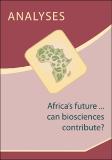| dc.contributor.author | Nigel J Taylor, Haruna A Sekabira, Kenneth W Sibiko, Anton Bua, John K Lynam | |
| dc.date.accessioned | 2020-08-27T08:46:32Z | |
| dc.date.available | 2020-08-27T08:46:32Z | |
| dc.date.issued | 2015 | |
| dc.identifier.uri | https://repository.maseno.ac.ke/handle/123456789/2438 | |
| dc.description.abstract | Originating from Latin America, the tuberous root crop cassava is now central to maintaining food security across much of tropical Africa. Cassava has been subject to a succession of pandemics, including cassava mealy bug and virulent forms of the two virus diseases, cassava mosaic disease (CMD) and CBSD. Indeed, virus diseases are presently estimated to cause annual losses of almost a third of the total crop. 1 CMD causes malformation of the leaves and reduced storage root yields, while CBSD induces serious necrosis of the edible roots, rendering the crop unfit for sale or consumption.
Over the last 15 years the incidence and severity of CBSD has increased, spreading beyond its traditional area of distribution in coastal East Africa to appear in Uganda and western Kenya. It is now spreading quickly through Central and Southern Africa to reach pandemic proportions. Delivery of robust, disease-resistant varieties to help cassava farmers secure their crop against the effects of CBSD is para mount but has proved to be difficult. Traditional breeding methods have been limited in their ability to tackle the disease due to lack of genetic resistance to the causal viruses in existing cassava varieties. | en_US |
| dc.publisher | in 2015 by Banson, 27 Devonshire Road, Cambridge CB1 2BH | en_US |
| dc.subject | cassava production, genetically modified (GM), | en_US |
| dc.title | Disease-resistant GM cassava in Uganda and Kenya during a pandemic | en_US |
| dc.type | Article | en_US |

